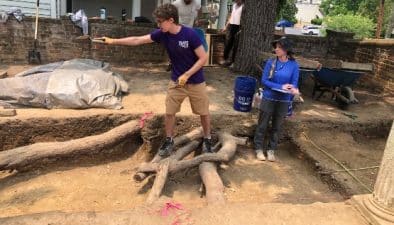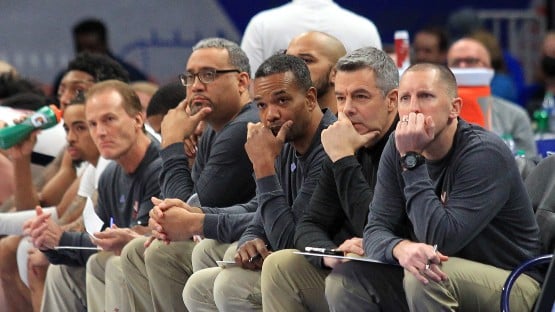
In June, Dr. Dennis Blanton and several students from JMU journeyed to Staunton and spent several weeks with their hands in the dirt.
Literally. Their digging into Staunton’s history and the lower terrace at the Woodrow Wilson Presidential Library and Museum, however, yielded the first discovery of its kind in Staunton, and one of few in the Shenandoah Valley.
In “The Surprise That Shouldn’t Be: Archaeological Evidence of a Slave Occupation at the Woodrow Wilson Birthplace in Staunton” Monday night, Blanton explained the history of digs at WWPL since 2018 and the artifacts recovered this past summer by JMU students.
“There’s no doubt that down there in the lower terrace is a very old slave-related occupation,” Blanton, associate professor of anthropology at JMU, said.
Archeology work since 2018 at WWPL has enabled Blanton and JMU students to fill “in something about the history of this community prior to the era that everybody begins to know and understand.”
Blanton spoke at WWPL in celebration of National Archaeology Month and as the spokesperson for the JMU student archaeology team who came to Staunton “to explore the backyard essentially of the manse.” Blanton holds a degree in anthropology from the University of Georgia, earned a PhD from UVA and has taught at JMU since 2013. The students were from a course called Archaeological Field Techniques.
For historical context
The Manse where the future President Thomas Woodrow Wilson would be born in 1856 was built in 1846 at the corner of Frederick and North Coalter streets in downtown Staunton. However, Blanton said, the house was built on an elevated parcel of land overlooking the Presbyterian churches in town and, at the time, was considered “outside” town.
“The property of the Manse was beyond the planned town,” he said. By design, the property was not in a center of town activity and the Manse was built in service of the church, in which it stayed until 1925.
Documents by Jedediah Hotchkiss, who was General Robert E. Lee’s cartographer, show the Manse and what is so far referred to as a stable on the property in 1884, but the stable dates to the 1850s. What was later known as a stable was previously the dwelling of enslaved peoples.
Mary Baldwin College took ownership of the property in 1929.
“They recognized it was a place worthy of preservation,” Blanton said.
In 1938, the Woodrow Wilson Birthplace Commission acquired the property.
“And the rest is history as far as this institution is concerned,” Blanton said.
JMU students dig up history
Blanton was invited in 2018 to dig for artifacts on the terraces behind the Manse. He admitted that he at first hesitated to accept the invitation. He did not expect to find anything of historical value to Wilson, Staunton or archaeology.
Three sets of enslaved peoples are recorded as working in the Manse: at least eight slaves owned by Rev. Benjamin Smith from 1846 to 1855; three slaves leased by Rev. Joseph Wilson from 1855 to 1858; and slaves leased by Rev. William Baker from 1858 to 1884. Rev. Wilson was President Wilson’s father.
Most enslaved peoples could not read or write, so their history was not recorded in the United States.
“The people in this status sadly become anonymous in the historical record,” Blanton said.

In a July 2018 dig with JMU students, the focus was to determine if anything of historical value had survived on the property. Shovel tests provide a sense of archaeological potential in land and are “windows into the past, into the ground were saying in no uncertain terms that there’s very good archaeology on this property.”
The original backyard at the Manse was buried on several layers. Blanton had expected to discover that when the Garden Club planted a presidential rose garden they had removed the original layer.
“So that sealed off, it preserved these early deposits,” Blanton said of the club’s work.
For archaeologists, it’s not about what they find, but what they find out. And the backyard of the Manse revealed a bridge to people in the past. “We learn to read the soil, but we also learn to think with things.”
Digs from 2019 to 2021 focused on finding the stories to be told. The ground was taken apart in the backyard and put together again in the lab. On the lower terrace, Blanton and his students did not find evidence of Presbyterians living on the land, but evidence of slaves.
The findings were rare and significant, especially to Staunton. The artifacts became the oldest that Blanton has seen in Staunton, much like what has been found at Monticello dating to the 1700s.
“It’s what you would expect in the household of lower socio-economic occupants,” he said.
Pig bones, black beads, smoking pipes and heirloom porcelain encouraged Blanton to believe that enslaved peoples occupied the land on the lower terrace.
The June 2023 dig was to confirm a slave-related occupation behind the Manse. Students also uncovered a Native American spear point dated 6000 to 5000 BC. Blanton said the name of the tribe could be lost to history and they were probably ancestors of Native Americans who lived on the land after the U.S. was established.
The most important artifact this summer to confirm the presence of enslaved peoples was a fastener with the image of a fist, which is always connected to enslaved peoples. The fastener found at Wilson’s birthplace is only the 13th piece found in the U.S., and all were made between 1819 and 1825. Others have been found in Virginia, Tennessee and on a plantation in Florida.
However, questions remain, including when did the enslaved peoples live on the property, whom were they associated with and what work did they do?
“We don’t know what they were doing. And that’s important for us to find out. We want to give them a story,” Blanton said.
In addition to the story of America’s 28th president and Presbyterians, WWPL now owns another incredible story to be told about vital members of a community.
“The most important story of all and that’s of these enslaved occupants,” Blanton said.
Related stories:
The story of slaves: Excavation might uncover evidence of late 1700s enslaved – Augusta Free Press










